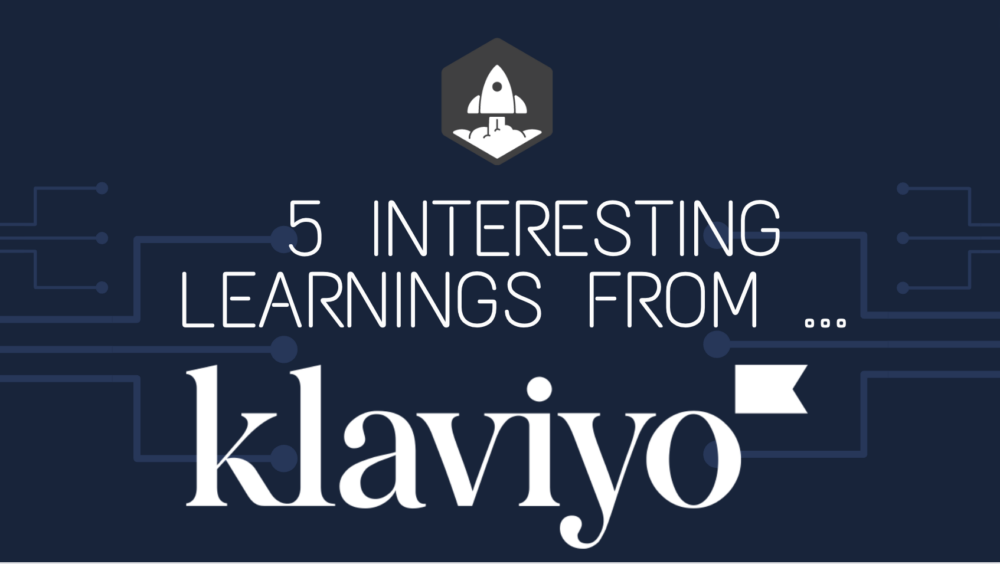5 Interesting Learnings from Klaviyo at $650,000,000+ in ARR
"Klaviyo CAC even at this scale is just 14 months."
So we’re finally, almost back from the IPO Drought in SaaS. The last SaaS leader to IPO was HashiCorp back in Dec 2021. After that, the public markets began a precipitous decline — leading to an almost 2-year pause in SaaS IPO.
But now we’re almost back. You may not have heard of Klaviyo until recently, if at all. But it’s the #1 break-out leader in the Shopify partner ecosystem, and the numbers are stunning:
$650m+ in ARR
Growing a stunning 56.5% at this scale (!!)
119% NRR from SMBs
Profitable, and only burned $15m net to date
130,000 total customers
There’s not much to not love here! The only real risk is Klaviyo’s deep dependence on Shopify, which we’ll touch on below. But the metrics, especially for an SMB-focused SaaS business, are breathtaking.
At SaaStr we’ve been super fans for a long time and a little ways back we did an amazing interview with CEO Andrew Bialceki here:
Our 5 Interesting Learnings here:
#1. 130,000 Customers, So About $5,000 on Average A Year Per Customer.
This is pretty impressive from SMBs, but the key is that every small store, every small business does need to market and acquire customers. And to do that, they need to build a list, and do email and SMS campaigns. Klaviyo automates a ton of that from inside Shopify.
#2. 110%+ NRR for 3+ Years. Getting above 100% NRR from true SMBs is tough.
But Klaviyo has done it, with 110%+ NRR for years.
#3. $50k+ Customers Growing the Fastest, at 94% Year-over-Year
While Klaviyo’s core customer is still a small SMB, it’s gone upmarket like most of us, and with a sales-driven motion. $50k+ customers are growing almost 100% a year now. Still, it’s taken its time 🙂 It’s stayed primarily SMB well into $500m+ in ARR. Shopify itself has only relatively recently truly pushed into the enterprise.
#4. 14 Month CAC
CAC (Customer Acquisition Cost) is one of those metrics there are about 10,000 ways to calculate. Still, it’s helpful when a SaaS leader actually breaks theirs out, as most don’t. Klaviyo said theirs even at this scale is a relatively short 14 months.
#5. Very Verticalized — 95% of Revenue in eCommerce and Retail
Kalviyo focused on ecommerce, ecommerce, ecommerce and it’s paid off. eCommerce alone will get them to $1B ARR. But they are beginning to diversify out of it now.
And a few other interesting learnings:
#6. 36% of Revenue Outside the U.S.
Not surprising– over 50% of HubSpot’s revenue is outside the U.S. But again a good reminder to go as global as you can.
#7. SMS is Growing Quickly, But The Vast Majority of Revenue is Around Email Marketing
SMS has taken off in marketing, and for Klaviyo, it’s grown from 8% of customers using SMS in 2021 to 15% today. But Klaviyo clearly isn’t SMS-first yet. In fact, they delivered a stunning 311 Billion emails over the last 12 months — and 2.8 Billion SMS messages.
#8. Very Efficient, But Did Get a Bit Leaner Recently to Do It
Klaviyo has always been efficient — but it got less efficient for the first time in 2021 (didn’t we all??), and saw its first real losses start accruing. They quickly got back to profitability, did an 8% layoff to get there faster, and then kept hiring lean to get back to sustained profitability for the past 6 months
#9. 70% of Revenue on the Shopify Platform
This is both the opportunity and the risk and the challenge. Shopify’s market share in eCommerce platforms has only grown over Klaviyo’s 13-year history, and today Shopify probably has about 70% or so market share in the eCommerce platform players. So it’s not surprising that 70% of Klaviyo’s revenue is also with Shopify customers. Shopify is also one of Klaviyo’s largest shareholders and has a deep revenue-sharing agreement, so the companies are closely linked. But diversifying off Shopify would be almost impossible for them — or most of the other leads in B2B e-commerce SaaS. Shopify’s the big whale, and also has the best integrations.
#10. Basically Zero Macro Impacts the Past Few Years
While eCommerce has had its own bumpy path since March 2020, it hasn’t impacted Klaviyo much. Not only is growth top, top tier — but it hasn’t really missed a beat over the past 2.5 years. The past quarter or two have seen some slowdown, but every there it’s fairly modest:
Wow. The first real SaaS IPO in 2 years will also be one of the best ones.
Klaviyo. Boom.
Note: tons of credit to Meritech’s analysis, where I borrowed several of their great charts!





